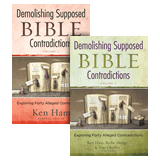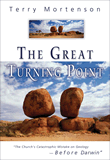
How Old-Earth Inerrantists Are Unintentionally Undermining Inerrancy
How theological scholars, who affirm the truthfulness of the Bible, sabotage its authority through their science-over-Scripture hermeneutic.
Ideas have consequences. In fact, ideas often have unintended consequences. American sociologist Robert K. Merton coined the term “law of unintended consequences” to illustrate that policy changes often have far-reaching consequences beyond the actual changes themselves. An example was the use of Agent Orange in the Vietnam War. The pesticide killed the foliage in the jungle so troops could fight easier, but it also gave cancer and possibly other diseases to those same troops.
It seems like old-earth theologians, many of whom also believe in biblical inerrancy, have stumbled upon an unintended consequence for their hermeneutic: undermining the very Bible they claim to uphold.
The Chicago Statement on Biblical Inerrancy (CSBI) is a clear statement of the Bible’s accuracy regarding everything it teaches. A biblical creationist could completely agree with everything in it, and even find seeming support for the plain interpretation of the creation account:
We deny that Biblical infallibility and inerrancy are limited to spiritual, religious, or redemptive themes, exclusive of assertions in the fields of history and science. We further deny that scientific hypotheses about earth history may properly be used to overturn the teaching of Scripture on creation and the flood.1
In 1982, the ICBI produced the “Chicago Statement on Biblical Hermeneutics” (CSBH). Article 15 affirms,
We affirm the necessity of interpreting the Bible according to its literal, or normal, sense. The literal sense is the grammatical-historical sense, that is, the meaning which the writer expressed. Interpretation according to the literal sense will take account of all figures of speech and literary forms found in the text.2
Article 22 seems to even contain a clear statement in support of creation:
We affirm that Genesis 1–11 is factual, as is the rest of the book. We deny that the teachings of Genesis 1–11 are mythical and that scientific hypotheses about earth history or the origin of humanity may be invoked to overthrow what Scripture teaches about creation.3
So, it might be surprising to learn that most of the signatories of these documents were old-earth creationists or theistic evolutionists. One of the leaders in the writing of the CSBI, Norman Geisler, said,
Most of the founders and framers of the early inerrancy movement of the 1900s (e.g., Warfield and Hodge) and the contemporary movement of the 1970–80s (e.g., the International Council on Biblical Inerrancy) held firmly to inerrancy but saw no necessary tie of it to a Young Earth view.4
Additionally, many of the signers have made public statements affirming various old-earth views regarding creation. How do they reconcile their old-earth views with their strong affirmations of inerrancy?
Additionally, many of the signers have made public statements affirming various old-earth views regarding creation.
Data Versus Interpretation
Article 20 of CSBH states, “We further affirm that in some cases extrabiblical data have value for clarifying what Scripture teaches, and for prompting correction of faulty interpretations.”5 Article 21 of CSBH states,
We affirm the harmony of special [revelation] with general revelation and therefore of biblical teaching with the facts of nature. We deny that any genuine scientific facts are inconsistent with the true meaning of any passage of Scripture.6
But sometimes, what old-earth creationists accept as “data” or “facts” are actually the interpretations of data. For instance, all geologists (both creationists and evolutionists) agree on the composition of the rock layers in the Grand Canyon. But the statement, “The layers of the Grand Canyon were deposited over the course of 300 million years, and the canyon was carved in about 5 million years by the Colorado River,” is an interpretation of the evidence. A biblical creationist interpretation would be, “The layers of the Grand Canyon were laid down by water during the global flood of Noah’s day, and the canyon was carved as the floodwaters drained from the continent.”
Biblical young-earth creationists, of course, agree that no fact from the natural world will contradict Scripture. However, the wording of this statement would allow for interpretations of facts to affect the interpretation of Scripture.
In fact, Scripture defines and limits general revelation. Romans 1:18–20 explains that creation reveals God’s existence and some of his attributes to all people in all places and at all times, regardless of their age, education, culture, or religion. The universality of the revelation is why people are without excuse when they fail to worship and thank God. This is also why the Bible calls the atheist a fool (Psalm 14:1) when he denies God’s existence, and why people are culpable for worshipping anything in creation rather than God.
History assures us that many things believed by the majority of scientists today will be rejected as false in the future.
However, old-earth creationists redefine general revelation as a collection of truth claims believed by most modern scientists and understood only by the fraction of modern humanity who understands twentieth and twenty-first century science. History assures us that many things believed by the majority of scientists today will be rejected as false in the future. Nowhere does Scripture teach that nature is infallible when teaching about the history and origin of the world. In other words, creation is not the 67th book of the Bible, as Hugh Ross erroneously teaches.
This also prompts one to consider what kinds of change in interpretation the CSBH would allow. While most would concede that extrabiblical sources could shed light on the meaning of a rarely used word in Scripture or clarify the historical context of a passage, Christians should be cautious about letting extrabiblical data change the meaning of Scripture to something that was never recognized in the history of Christian interpretation of Scripture. Extrabiblical data can add the equivalent of color to a black-and-white photo, but it should not be allowed to change the entire picture!
Unfortunately, old-earth creationists, perhaps unintentionally, end up allowing extrabiblical interpretations of data to change critical details of the picture where there is no biblical justification to do so. The timeframe is stretched from a little over 6,000 years to around 13.8 billion years. The order of creation is also changed. In the biblical account, God created the stars on day four, after the earth, sea, dry land, and plants. The evolutionary account has stars forming long before the earth and plants. But because of the CSBH loophole, the “extrabiblical” evidence can be used to radically alter the timescale and order of creation while remaining inerrantist.
Theological Implications
Old-earth creation has theological as well as historical implications, because it also places death and disease in the animal world before human sin. All old-earth views accept millions of years of what philosophers call “natural evil.” In contrast, Christians have historically recognized that both moral evil (sinful actions of human beings like murder, adultery, and theft) and natural evil (disease, famine, hurricanes, etc.) are the result of Adam’s sin and God’s resulting curse on creation. By asserting that natural evil was not introduced at the fall, but was part of God’s design at creation, old-earth creationists radically reinterpret the creation account.
Misplaced Hermeneutical Humility
The CSBI was released over 40 years ago, but old-earth inerrantists today repeat the same errors. Until his death in 2019, leading inerrantist Norman Geisler maintained belief in an old earth. He stated, “The problem is deepened by the fact that there is prima facie evidence to indicate that the days of Genesis are indeed 24 hour periods.”7 However, he claims, “Scientific dating has demonstrated that life emerged gradually over many millions of years. . . Most scientific evidence sets the age of the world at billions of years.”8 In other words, what he wrongly views as “general revelation” overrules what he recognizes to be special revelation!
The late R. C. Sproul, another old-earth inerrantist, was interviewed on Tim Challies’ popular blog. Challies asked him, “Have you ever had second thoughts about the stand that you took in favor of a six-day creation and a young earth, especially in view of all the new material on the subject that has come out since 2006?”9 Sproul responded,
Well, that’s kind of a complex question because when I took the stand, I took the stand on a six-day creation. I didn’t take a stand on a young earth. I don’t know how old the earth is. I didn’t know then. I still don’t. And what do we mean by “young earth”? If you’re thinking six thousand years, I doubt that. If you’re thinking 12 billion years, I doubt that, too. All I was speaking about was the understanding of what the Scriptures teach regarding the six days of creation. And I’m not even sure it’s correct to say that I took a stand. I said that’s what my view was. When you say you have a view, it’s one thing to say, “I think that this is the way it is.” It’s another thing to take a stand where you say: “Here I stand. I’m going to die on this mountain.” I could be wrong in my understanding of Genesis. It’s very difficult to deal with the literary genre in the opening verses of the beginning chapters of Genesis. I think there has to be some room for some flexibility on it.10
However, there are multiple literary markers that Genesis 1–11 is historical narrative and not poetry or myth. And the genealogies in Genesis 5 and 11, combined with other equally historical and chronological statements throughout the rest of the Old Testament, give us a clear timeline of a little over 6,000 years from creation to today.
Given the clarity of the biblical evidence, why did Sproul doubt the young-earth timeline? At a conference, Sproul said the following:
For some people, it’s an all-or-nothing issue. When people ask me how old the earth is, I tell them I don’t know. Because I don’t. And I’ll tell you why I don’t. In the first place, the Bible does not give us a date of creation. Now it gives us hints and inclinations that would indicate in many cases, a young earth. And at the same time, you get all this expanding universe and all this astronomical dating and triangulation and all that stuff coming from outside the church that makes me wonder.11
[Sproul] acknowledged that the biblical data indicates a young earth, but the evolutionary interpretations of scientific data make him unsure of the actual history of the world.
In other words, he acknowledged that the biblical data indicates a young earth, but the evolutionary interpretations of scientific data make him unsure of the actual history of the world. The weight he gives to this evolutionary interpretation makes him both minimize the biblical data (it is possible to create a timeline from creation to the birth of Christ using the biblical data, which is more than “hinting” at a young earth) and consider a view of earth history that is nowhere in Scripture in hints, implications, or otherwise.
It might seem humble to allow for uncertainty regarding the age of the earth, but it is actually arrogant to insert uncertainty where Scripture is clear. Unfortunately, evangelicalism is filled with similar “theoretical inerrantists” who take an otherwise strong stance on Scripture but unfortunately allow for evolutionary views.
Science over Scripture?
Article 20 of CSBH states, “We deny that extra-biblical views ever disprove the teaching of Scripture or hold priority over it.”12 But in fact, they allow the interpretations of the scientific majority to determine their views on the age of the earth and Noah’s flood. Those long-age interpretations are the only reason for the hermeneutical false humility that claims Scripture is less than clear regarding creation and the age of the earth. Reinterpreting these parts of the Bible to accommodate long ages is another way of saying that the Bible is in error.
Equally concerning is that many do not attach much importance to the age of the earth. They do not study Genesis 1–11 carefully and are not familiar with the work done by young-earth scientists and theologians. As a result, the vast majority of Bible scholars and Christian leaders over the last two centuries have uncritically accepted claims that rest on a foundation of naturalistic philosophy that is fundamentally hostile to Christianity.
Geological Evolution: A Naturalistic Myth
When people think of evolution, they normally think of the biological idea that all life is descended from a common ancestor, a single-celled creature generated from a primordial soup. However, just as important to the naturalistic worldview is geological evolution, the idea that the stars and planets formed over billions of years following the first event in the universe, the big bang. Geological evolution further states that geological uniformitarianism can best explain earth’s geological history.
For the first 1800 years of church history, almost universally, Christians believed in what could be termed “young-earth creationism.”
For the first 1800 years of church history, almost universally, Christians believed in what could be termed young-earth creationism. An early-nineteenth century group of geologists known as the “scriptural geologists” defended the biblical view against long-age views. They raised biblical, geological, and philosophical arguments against various old-earth views that were developing at the time. Particularly, they affirmed the six-day creation, a global flood in Noah’s day, and the earth’s age of around 6,000 years old.
After 1840, the uniformitarian view became the ruling dogma in geology. As uniformitarians became professors and taught that view to their students, it became the dominant view, crowding out biblical geology.
Charles Lyell, the uniformitarian most responsible for that view’s dominance, was not coming from an impartial view of dispassionately weighing the evidence—he was overtly anti-biblical. His goal was to “free the science [of geology] from Moses.”13
So what we have is two views, one Christian and one anti-Christian, competing over two views of world history, using the evidence in the present to try to reconstruct what happened in the past. The difference is that Christians have an inerrant, inspired record of world history that records geologically significant events—creation and the global flood of Noah’s day. When old-earth inerrantists take the side of the uniformitarians, they are agreeing with them that the Bible’s historical record is somehow lacking, or even in error.
Darwin was directly influenced by Lyell’s uniformitarianism and applied the same naturalism to biology. In 1844 he wrote,
I always feel as if my books came half out of Lyell’s brains and that I never acknowledge this sufficiently, nor do I know how I can, without saying so in so many words—for I have always thought that the great merit of the Principles [of Geology], was that it altered the whole tone of one’s mind & therefore that when seeing a thing never seen by Lyell, one yet saw it partially through his eyes.14
However, some modern geologists reject uniformitarianism. Some non-Christian geologists, such as Derek Ager, who wrote a book entitled The New Catastrophism, argue from a naturalistic basis that some geological evidence can be better explained by rapid, catastrophic formation than by slow and gradual processes over long periods of time.
While these naturalistic catastrophists may be as hostile to Scripture as Lyell was and operate with the assumption of the same timescale, their alternate view of geology shows that the geological evidence is open to interpretation and that criticism of uniformitarianism is by no means limited to the religious.
Cosmological Evolution: A Naturalistic Myth
The big bang theory is another piece of the naturalistic myth that is increasingly under attack even from secularists. Popular science writer Eric Lerner wrote,
Big bang theory today relies on a growing number of hypothetical entities—things that we have never observed. Inflation, dark matter and dark energy are the most prominent. Without them, there would be fatal contradictions between the observations made by astronomers and the predictions of the big bang theory. In no other field of physics would this continual recourse to new hypothetical objects be accepted as a way of bridging the gap between theory and observation. It would, at the least, raise serious questions about the validity of the underlying theory.15
Lerner is far from the only astrophysicist that shares these views. The late Halton Arp, who died in 2013, rejected the big bang and wrote, “Scientists, particularly at the most prestigious institutions, regularly suppress and ridicule findings which contradict their current theories and assumptions . . . astronomers now feel compelled to fit the observations to the theory and not vice versa.”16
These secularist dissenters from the big bang theory show that the only reason the big bang appears to be a fact is because its proponents are suppressing contrary views.
These secularist dissenters from the big bang theory show that the only reason the big bang appears to be a fact is because its proponents are suppressing contrary views. Not only is it impossible to harmonize these naturalistic paradigms with Scripture, they are not even accepted by some eminent naturalists!
Old-earth inerrantists likely have sincere intentions to “save” Genesis from what they mistakenly view as proven science by allowing it to control their interpretation. However, by doing so, they undermine the inerrancy and thus the authority of the Bible.
Biblical Creationist Response to Old Earth Inerrantists
The preface to CSBI said,
We invite response to this statement from any who see reason to amend its affirmations about Scripture by the light of Scripture itself, under whose infallible authority we stand as we speak. We claim no personal infallibility for the witness we bear, and for any help which enables us to strengthen this testimony to God’s Word we shall be grateful.17
A group of fourteen inerrantist scholars, most of them Bible professors, responded to this invitation by producing a supplement statement of affirmations and denials. It was published in Coming to Grips with Genesis: Biblical Authority and the Age of the Earth18 and is also available on the AiG website. Anyone who has a master’s degree or higher in some field of theology can sign the document. Although Coming to Grips with Genesis has been sold at many annual Evangelical Theological Society meetings, it seems that old-earth theologians have largely ignored the book and its arguments.
While it is possible to be an inerrantist and believe in evolution and/or millions of years, it is not consistent, and requires old-earth inerrantists to play hermeneutical tricks that undermine inerrancy itself.
While it is possible to be an inerrantist and believe in evolution and/or millions of years, it is not consistent, and requires old-earth inerrantists to play hermeneutical tricks that undermine inerrancy itself. Many Christian leaders who proudly proclaim “sola Scriptura” unintentionally actually practice “sola Scientia” (science alone) when they allow the interpretations of naturalistic scientists to control their interpretation of the first chapters of the Bible.
Conclusions
It is clear from the Bible’s own witness and the unanimous interpretation of the Church for the first 1800 years of its existence that Genesis 1–11 is history. If Scripture is the only inerrant book, we must affirm its teachings over any other truth claims. It must be the supreme authority in everything that it teaches—not only in matters of theology and morality, but in any area its pronouncements touch—including history and science. We cannot separate the Bible’s inerrancy from its authority.
Theologians demonstrate true humility when they handle Scripture with reverence, taking seriously its claims and allowing Scripture to interpret Scripture, rather than reinterpreting Scripture to fit with naturalistic philosophy that is fundamentally hostile to biblical claims.
Christians should not be afraid to stand firmly on the foundation of Scripture and boldly proclaim and defend what God clearly says regarding the creation and history of the world. As America and the rest of the once-Christian West sink deeper into moral insanity, wickedness, and animosity toward Bible-believing Christians, may God help us to be faithful in the tremendous battle over the truth of God’s inerrant and supremely authoritative Word.
Further Reading
Answers in Depth
2022 Volume 17
Answers in Depth explores the biblical worldview in addressing modern scientific research, history, current events, popular media, theology, and much more.
Browse VolumeFootnotes
- Chicago Statement on Biblical Inerrancy, Article XII, 1978, https://www.etsjets.org/files/documents/Chicago_Statement.pdf.
- Chicago Statement on Biblical Hermeneutics, Article XV.
- Chicago Statement on Biblical Hermeneutics, Article XXII.
- Norman Geisler, “Reviews,” Christian Apologetics Journal 11, no. 2 (Fall 2013): 167–174.
- Chicago Statement on Biblical Hermeneutics, Article XX.
- Chicago Statement on Biblical Hermeneutics, Article XXI.
- Norman Geisler, Baker Encyclopedia of Christian Apologetics (Grand Rapids, Michigan: Baker Books, 1999), 270.
- Norman Geisler, “Beware of Philosophy: A Warning to Biblical Scholars.” Journal of the Evangelical Theological Society 42, no. 1 (March 1999): 3–19.
- Tim Challies, “An Interview with R. C. Sproul.” https://www.challies.com/interviews/an-interview-with-r-c-sproul/, July 23, 2012.
- R. C. Sproul, Truths We Confess: A Layman’s Guide to the Westminster Confession of Faith, Vol. 1 (Phillipsburg, New Jersey: P&R Publishing, 2006), 121.
- “Ligonier Ministries, “Science, Scripture, and the Age of the Universe,” https://vimeo.com/41386833, accessed August 28, 2020. The 4-minute clip of Sproul is part of the answer to the last question in the Questions and Answers #2 session of the 2012 Ligonier National Conference.
- Chicago Statement on Biblical Hermeneutics, Article XX.
- Charles Lyell, quoted in Katherine Lyell, Life, Letters and Journals of Sir Charles Lyell, Bart, Vol. 1 (London, United Kingdom: John Murray, 1881), 268.
- Letter 772, to his good friend Leonard Horner, August 29, 1844.
- Eric J. Lerner, “Bucking the Big Bang,” New Scientist 182, no. 2448 (May 22, 2004): 20. The whole article with the listed signatories is at https://web.archive.org/web/20140401081546/http://cosmologystatement.org/.
- Halton Arp, Seeing Red: Redshifts, Cosmology and Academic Science (Montreal, Canada: Apeiron, 1998), 12.
- Chicago Statement on Biblical Hermeneutics, Preface.
- Terry Mortenson and Thane H. Ury, eds., Coming to Grips with Genesis: Biblical Authority and the Age of the Earth (Green Forest, Arkansas: Master Books, 2008).
Recommended Resources

Answers in Genesis is an apologetics ministry, dedicated to helping Christians defend their faith and proclaim the good news of Jesus Christ.
- Customer Service 800.778.3390
- © 2024 Answers in Genesis






